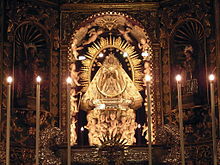Bajada de la Virgen de las Nieves
The Bajada de la Virgen de las Nieves ( German descent of the Virgin of the Snows ) is the most important, religious and secular festival on to Spain belonging Canary Island of La Palma . It takes place every five years, the last time in 2015.
History and customs
The occasion was a major drought in 1676. To avert a threatened crop failure, the Palmeros carried the image of Mary from the church of Las Nieves down to the coastal town of Santa Cruz to ask for help. The Virgen de las Nieves ( German Virgin of the Snow ) had been the patron saint of the island since 1534 , especially against storms, pirate attacks and volcanic eruptions. When it did rain, the Bishop of the Canary Islands, Bartolomé García Ximenéz , ordered the procession to be repeated every five years from 1680.
The Virgin of the Snow , a terracotta figure from the 14th century, is brought down on a sedan chair from her pilgrimage church of Las Nieves to the town about six kilometers away, where she is in the church of El Salvador in Plaza de España in Santa Cruz remains for the duration of the celebrations. The festival ends with the return of the Virgin to Las Nieves.
In the course of time, new festival customs were added to this Bajada. In the 18th century, parades of giants and stubborn heads were held, depicting local politicians and personalities, fairy tale characters and comic characters. The dance of the dwarfs ( La Danza de los Enanos ) developed from this and has been the climax of the Bajada since 1905. For the Bajada in 2000, the Palmerian artist Luis Morera created the dwarf as a bronze statue on the Plaza de La Alameda in Santa Cruz.
The modern Bajada is accompanied by a large number of concerts, traditional costume and dance performances, theater and competitions and lasts from the last Sunday in June to August 5th. Many Palm Eros who live abroad use the time and the festivities to visit their homeland.
Web links
Individual evidence
- ^ Official website of the Bajada ( Memento of January 16, 2015 in the Internet Archive ).
- ↑ http://www.el-sur.de/lapalma/reiseinformationen/traditionelle-fiestas/ (link not available)
- ↑ La Palma - The Bajada de la Virgen
- ↑ Giants and "big heads" on the Bajada de La Virgen de Las Nieves 2005
- ↑ Susanne Lipps: La Palma DuMont travel paperback, La Palma, 2012 (Zwergentanz / S. 78, Bajada / S. 38).
- ↑ R. Goetz: La Palma, active vacation on the greenest of the Canary Islands. 5th edition. Peter Meyer Travel Guide, Frankfurt am Main, 2000 (Bajada / p. 92-94).


